Optimizing Built-in Refrigerator Integration: BEHAVIOR Model for Evaluating Kitchen Workflow and Spatial Adaptability
Abstract
1. Introduction
1.1. Research Background and Significance
1.2. Literature Review
1.2.1. Evolution of Embedded Refrigerators and Adaptation Challenges
1.2.2. User Movement and Kitchen Interaction Patterns
1.2.3. Spatial–Product–Behavior Adaptation Frameworks
2. Materials and Methods
2.1. BEHAVIOR Model Development
2.2. Evaluation Weighting Strategy
2.3. Experimental Design and Data Collection
3. Results
3.1. Evaluation Results of Kitchen Layouts
3.2. Weight Distribution and Key Influencing Factors
3.2.1. Expert Subjective Weighting
3.2.2. User Objective Weight
3.3. Bottlenecks and Scenario-Specific Findings
3.3.1. Spatial Circulation Path Visualization Analysis
3.3.2. Comprehensive Weighting and Evaluation Analysis
4. Discussion
4.1. Model Validity and Contribution
4.2. Design Implications and Practical Optimization
4.3. Limitations and Future Research
5. Conclusions
Author Contributions
Funding
Institutional Review Board Statement
Informed Consent Statement
Data Availability Statement
Conflicts of Interest
References
- Dataintelo. Global Embedded Refrigerator Market—Industry Analysis, Trends, Market Size & Forecast 2024–2032. Available online: https://dataintelo.com/report/embedded-refrigerator-market (accessed on 2 July 2025).
- Sina Finance. The Era of Integrated Kitchen: A Shift Toward Embedded Appliances. Available online: https://finance.sina.com.cn/jjxw/2024-08-29/doc-incmhrnk4330551.shtml (accessed on 2 July 2025). (In Chinese).
- Sina Technology. World’s First Scenario-Based Refrigerator Standard Released. Available online: https://finance.sina.com.cn/tech/roll/2025-05-22/doc-inexmnkz5014511.shtml (accessed on 2 July 2025). (In Chinese).
- Gheorghe, A.C.; Andrei, H.; Diaconu, E.; Andrei, P.C. Advances in Reducing Household Electrical and Electronic Equipment Energy Consumption in Standby Mode: A Review of Emerging Strategies, Policies, and Technologies. Energies 2025, 18, 965. [Google Scholar] [CrossRef]
- Tsang, T.W.; Wong, L.T.; Mui, K.W.; Poon, C.Y. Influences of Home Kitchen Designs on Indoor Air Quality. Indoor Built Environ. 2023, 32, 1429–1438. [Google Scholar] [CrossRef]
- Guan, C.; Lin, B. Why do Consumers Purchase Energy-Efficient Kitchen Appliances? An Analysis Based on Online Review Comments. J. Environ. Manag. 2025, 373, 123791. [Google Scholar] [CrossRef]
- Shenzhen Home Appliance Industry Association. Technical Specification for Embedded Refrigerator Installation: T/SZFA 1015—2024. Available online: https://qxb-img-osscache.qixin.com/standards/3afa281002eb156b2ae431f54baacb4d.pdf (accessed on 2 July 2025). (In Chinese).
- Haier Group. An Installation Structure Linking the Door Panel of an Embedded Refrigerator and the Cabinet Door. Patent CN106369919A, 11 September 2018. [Google Scholar]
- Vengalis, T. Optimizing the Performance of Open-Type Refrigerated Display Cabinets: Block Schemes and Key Tasks. Power Eng. Eng. Thermophys. 2024, 3, 134–147. [Google Scholar] [CrossRef]
- Mihalache, O.A.; Møretrø, T.; Borda, D.; Dumitraşcu, L.; Neagu, C.; Nguyen-The, C.; Nicolau, A.I. Kitchen Layouts and Consumers’ Food Hygiene Practices: Ergonomics versus Safety. Food Control 2022, 131, 108433. [Google Scholar] [CrossRef]
- Li, Y.; Ghazilla, R.A.R.; Abdul-Rashid, S.H. QFD-based research on sustainable user experience optimization design of smart home products for the elderly: A case study of smart refrigerators. Int. J. Environ. Res. Public Health 2022, 19, 13742. [Google Scholar] [CrossRef]
- Ismatullaev, U.V.U.; Saduakas, A.; Kim, K. Human factors considerations in design for the elderly. Hum. Factors Aging Spec. Needs 2022, 38, 23–33. [Google Scholar] [CrossRef]
- Damen, D.; Doughty, H.; Farinella, G.M.; Fidler, S.; Furnari, A.; Kazakos, E.; Moltisanti, D.; Munro, J.; Perrett, T.; Price, W.; et al. Scaling Egocentric Vision: The EPIC-Kitchens Dataset. In Proceedings of the European Conference on Computer Vision (ECCV), Munich, Germany, 8–14 September 2018; pp. 720–736. [Google Scholar]
- Liu, M.; Suh, S.; Zhou, B.; Gruenerbl, A.; Lukowicz, P. Smart-Badge: A Wearable Badge with Multi-Modal Sensors for Kitchen Activity Recognition. In Proceedings of the Adjunct Proceedings of the 2022 ACM International Joint Conference on Pervasive and Ubiquitous Computing and the 2022 ACM International Symposium on Wearable Computers, Cambridge, UK, 11–15 September 2022; pp. 356–363. [Google Scholar]
- Liu, M.; Suh, S.; Vargas, J.F.; Zhou, B.; Grünerbl, A.; Lukowicz, P. A Wearable Multi-Modal Edge-Computing System for Real-Time Kitchen Activity Recognition. In International Joint Conference on Artificial Intelligence; Springer: Singapore, 2024; pp. 132–145. [Google Scholar]
- Shu, Y.; Zhang, G.; Liu, K.; Tang, J.; Xu, L. A framework for mining lifestyle profiles through multi-dimensional and high-order mobility feature clustering. arXiv 2023, arXiv:2312.00411. [Google Scholar]
- Sandholm, T.; Lee, D.; Tegelund, B.; Han, S.; Shin, B.; Kim, B. Cloudfridge: A testbed for smart fridge interactions. arXiv 2014, arXiv:1401.0585. [Google Scholar] [CrossRef]
- Kiran, T.P.; Verma, A.; Atreya, S. A smart compact kitchen layout to optimize space utilization. In Proceedings of the International Conference of the Indian Society of Ergonomics, Aligarh, India, 8–10 December 2021; Springer International Publishing: Cham, Switzerland, 2021; pp. 537–548. [Google Scholar]
- Chen, S.; Lyu, J.; Pang, Z.; Chen, M. Research on Design Evaluation of L-Shaped Kitchen Cabinets Based on Fuzzy Analytic Hierarchy Process. E3S Web Conf. 2020, 179, 2077. [Google Scholar] [CrossRef]
- Lin, H.; Deng, X.; Yu, J.; Jiang, X.; Zhang, D. A study of sustainable product design evaluation based on the analytic hierarchy process and deep residual networks. Sustainability 2023, 15, 14538. [Google Scholar] [CrossRef]
- Luo, Y.; Ni, M.; Zhang, F. A design model of FBS based on interval-valued Pythagorean fuzzy sets. Adv. Eng. Inform. 2023, 56, 101957. [Google Scholar] [CrossRef]
- Xiao, X.P. Innovative Design and Research of Steam Ovens Based on the FBS Model. Master’s Thesis, South China University of Technology, Guangzhou, China, 2020. [Google Scholar]
- Zhang, X.Q.; Li, R.H. Study on Pleasant Expressions and Product Styles—A Case of Humidifiers. Design 2024, 9, 40. [Google Scholar] [CrossRef]
- Xu, K.; Wang, W. Research on Interactive Design of Smart Kitchens Based on Elderly Users as a Special Group. Design 2023, 8, 3715. [Google Scholar] [CrossRef]
- Li, Y.; Li, X.Y.; Wang, M. Research on Scenario-Based Innovation in Home Appliance Design Based on AIoT. Softw. Eng. Appl. 2021, 10, 772. [Google Scholar]
- Lee, J.C.H. Spatial User Interface: Augmenting Human Sensibilities in a Domestic Kitchen. Doctoral Dissertation, Massachusetts Institute of Technology, Cambridge, MA, USA, 2005. [Google Scholar]
- Bonaccorsi, M.; Betti, S.; Rateni, G.; Esposito, D.; Brischetto, A.; Marseglia, M.; Dario, P.; Cavallo, F. ‘HighChest’: An Augmented Freezer Designed for Smart Food Management and Promotion of Eco-Efficient Behaviour. Sensors 2017, 17, 1357. [Google Scholar] [CrossRef]
- Tang, T.; Bhamra, T. Putting consumers first in design for sustainable behaviour: A case study of reducing environmental impacts of cold appliance use. Int. J. Sustain. Eng. 2012, 5, 288–303. [Google Scholar] [CrossRef]
- Carnesecchi, M.; Rizzo, A.; Alessandrini, A.; Caporali, M.; Milani, M. Designing iLook: An Integrated, Zoomable Interface to Support Users’ Interaction with Networked Home Appliances. PsychNology J. 2011, 9, 223–243. [Google Scholar]
- Olivier, P.; Xu, G.; Monk, A.; Hoey, J. Ambient kitchen: Designing situated services using a high fidelity prototype environment. In Proceedings of the 2nd International Conference on Pervasive Technologies Related to Assistive Environments, Corfu, Greece, 9–13 June 2009; pp. 1–7. [Google Scholar]
- Eom, S.; Zhou, H.; Kaur, U.; Voyles, R.M.; Kusuma, D. TupperwareEarth: Bringing intelligent user assistance to the “Internet of Kitchen Things”. IEEE Internet Things J. 2022, 9, 13233–13249. [Google Scholar] [CrossRef]
- Lee, C.H.J.; Bonanni, L.; Espinosa, J.H.; Lieberman, H.; Selker, T. Augmenting kitchen appliances with a shared context using knowledge about daily events. In Proceedings of the 11th International Conference on Intelligent User Interfaces, Sydney, Australia, 29 January–1 February 2006; pp. 348–350. [Google Scholar]
- Zhou, T.; Kuscsik, Z.; Liu, J.G.; Medo, M.; Wakeling, J.R.; Zhang, Y.C. Solving the apparent diversity–accuracy dilemma of recommender systems. Proc. Natl. Acad. Sci. USA 2010, 107, 4511–4515. [Google Scholar]
- International Code Council. International Plumbing Code (IPC): 2024 Edition; International Code Council: Washington, DC, USA, 2024; Available online: https://codes.iccsafe.org/content/IPC2024P1/chapter-8-special-rooms-and-spaces (accessed on 8 October 2025).
- Martilla, J.A.; James, J.C. Importance-performance analysis. J. Mark. 1977, 41, 77–79. [Google Scholar] [CrossRef]
- Sun, H.; Sun, X. The impact of scenario-based services on value co-creation in intelligent interconnected environments. J. Northeast. Univ. (Nat. Sci. Ed.) 2023, 44, 1663. [Google Scholar]
- Xiao, Z.F. Data application analysis of factor analysis in SPSS software. Sci. Technol. Commun. 2020, 12, 157–158. [Google Scholar]
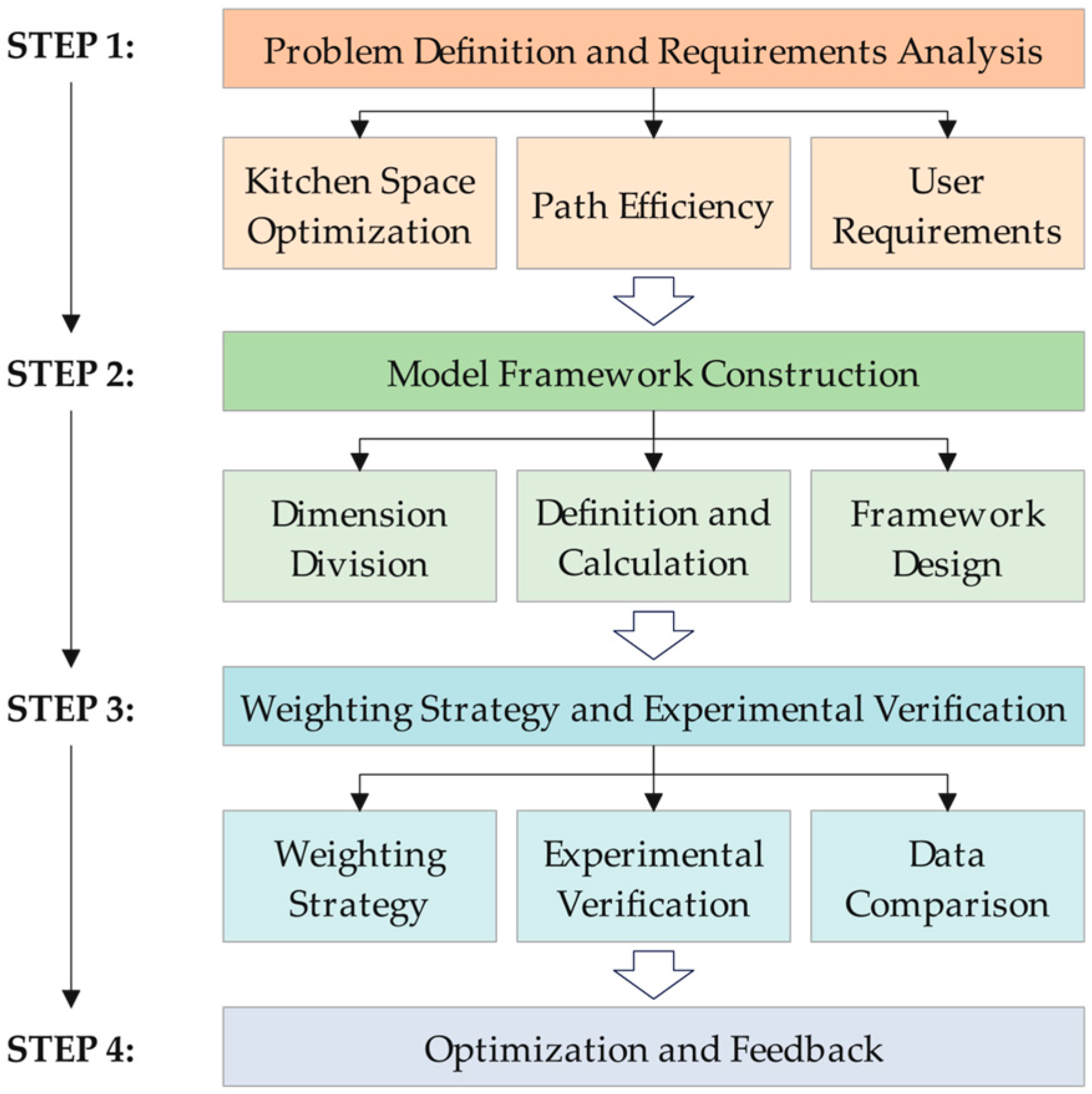
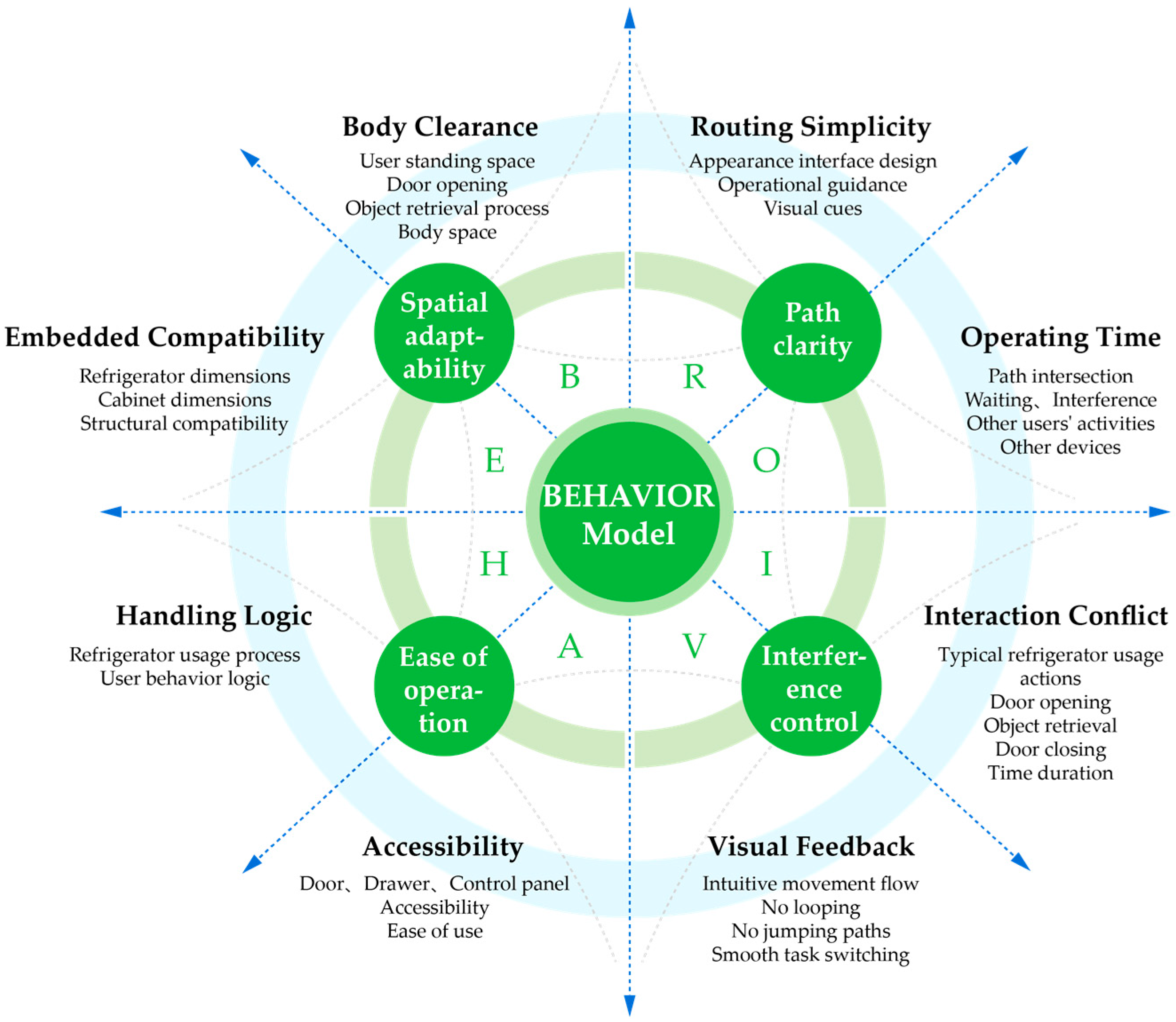
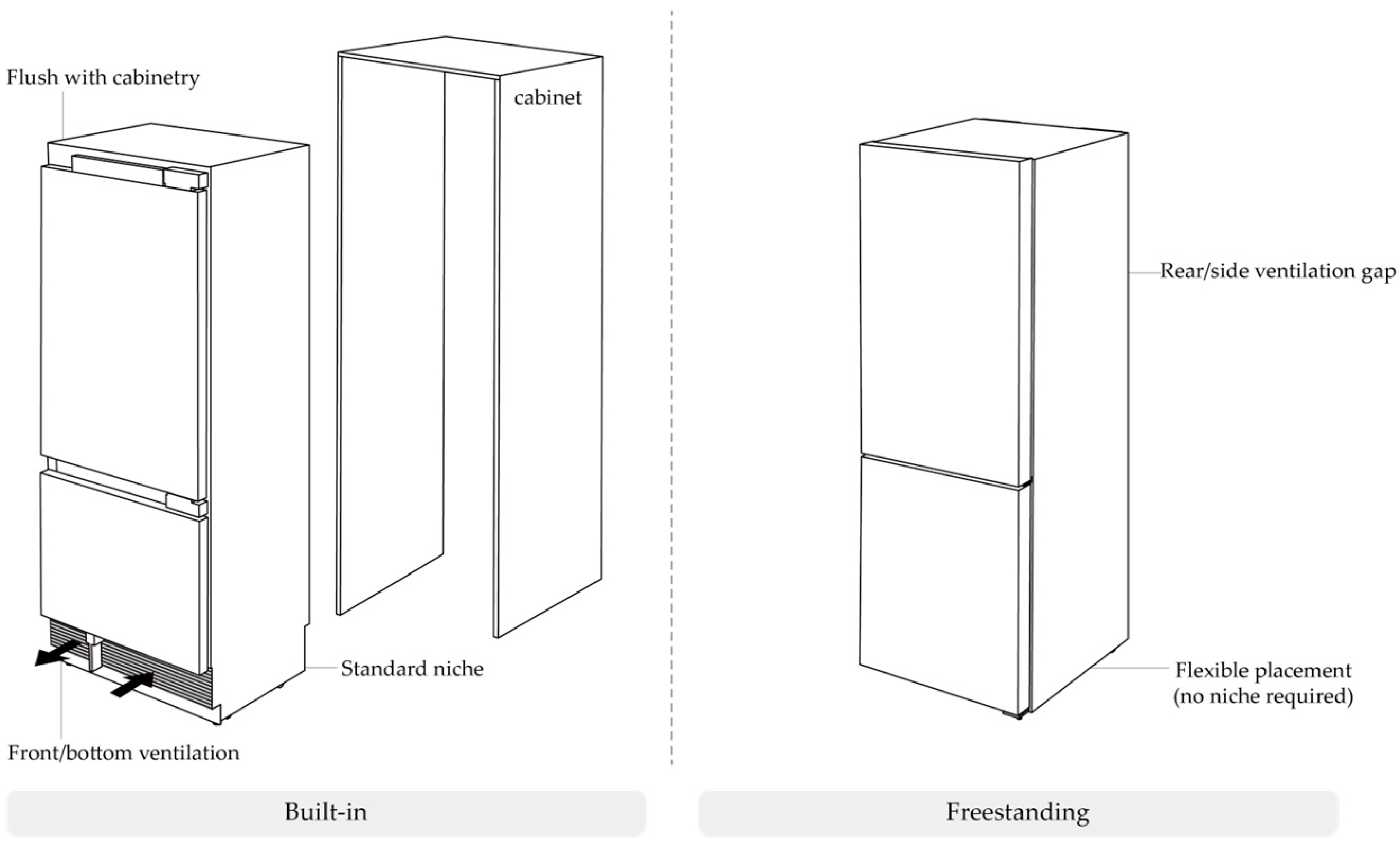

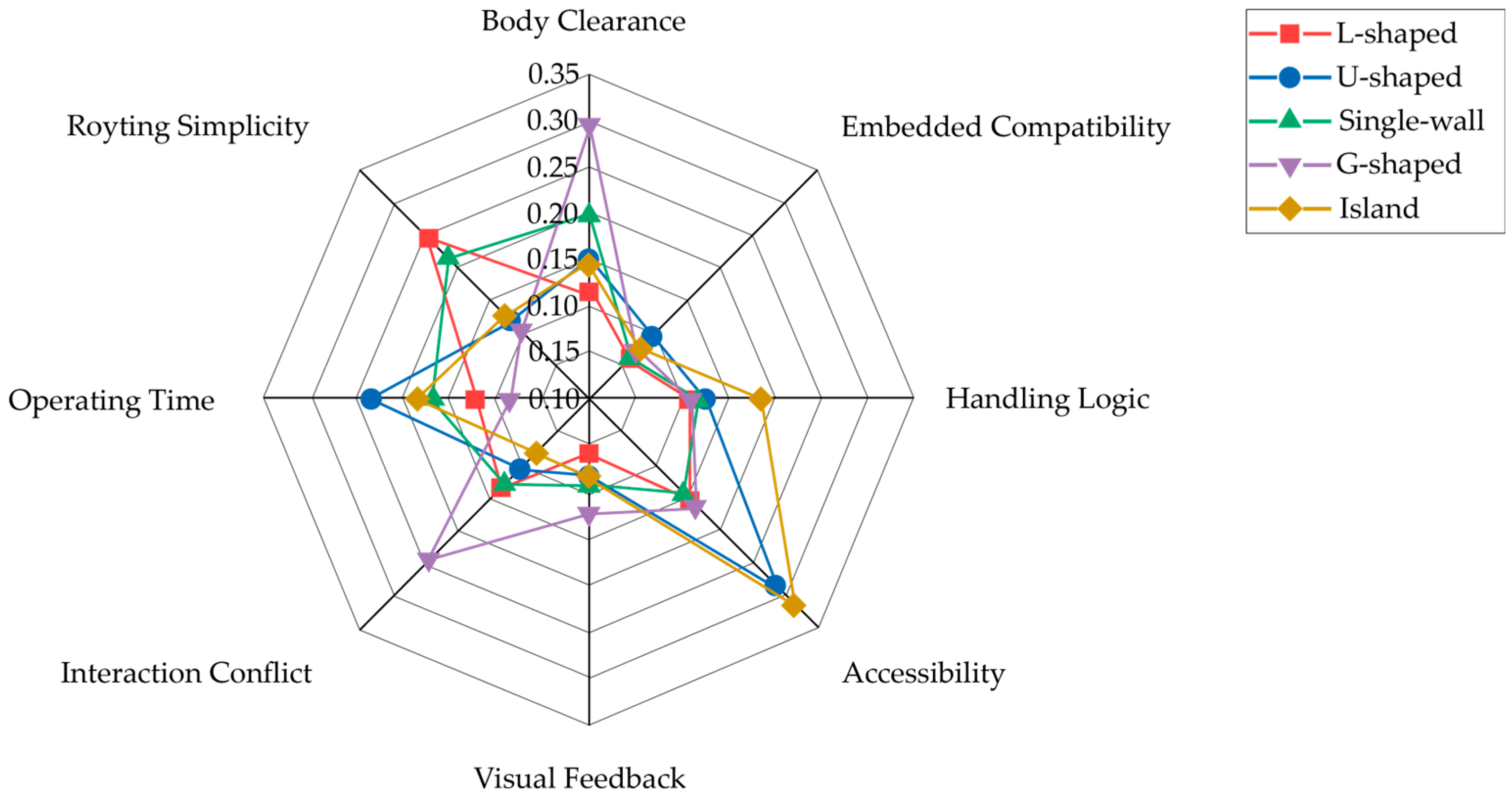
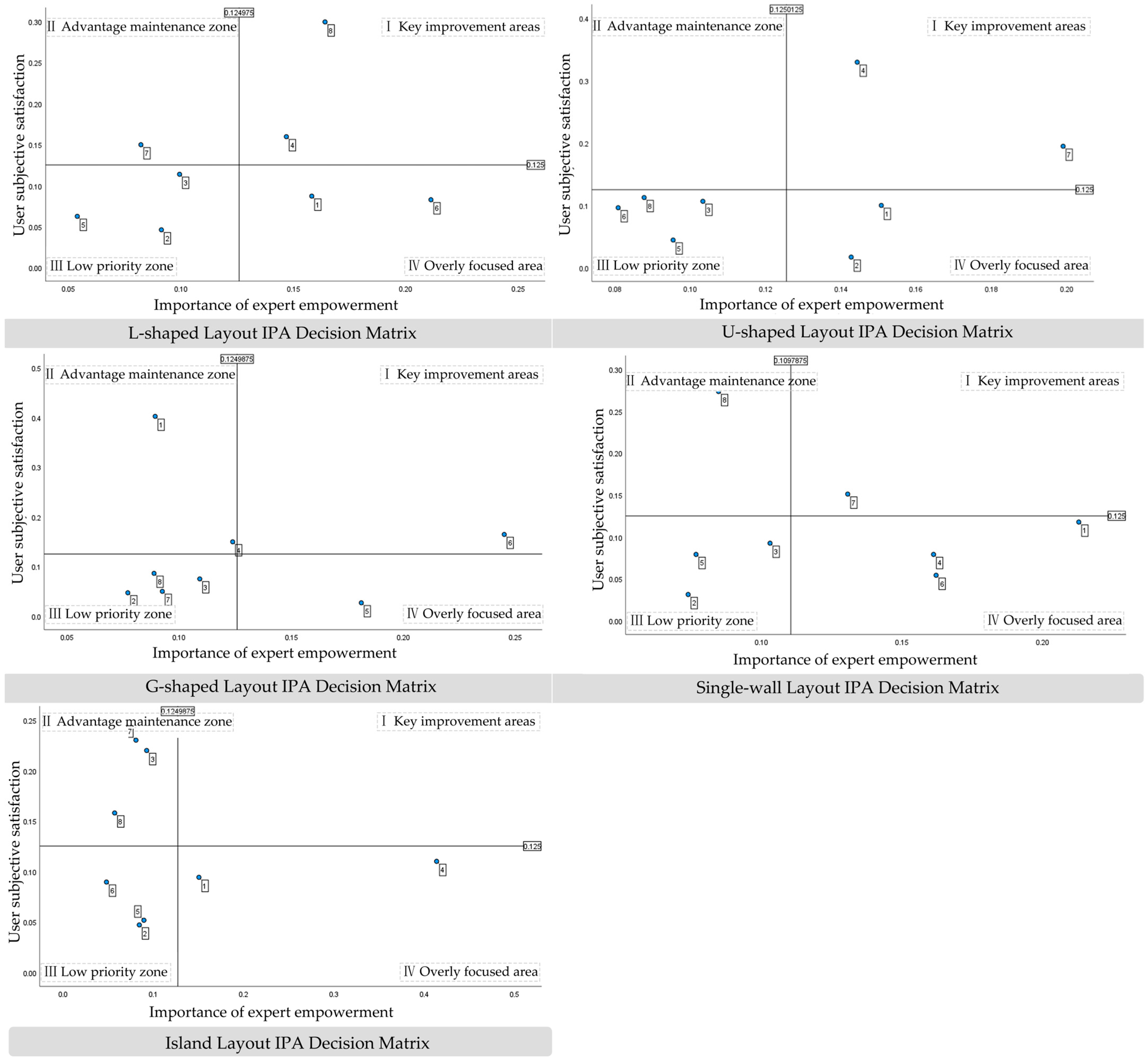
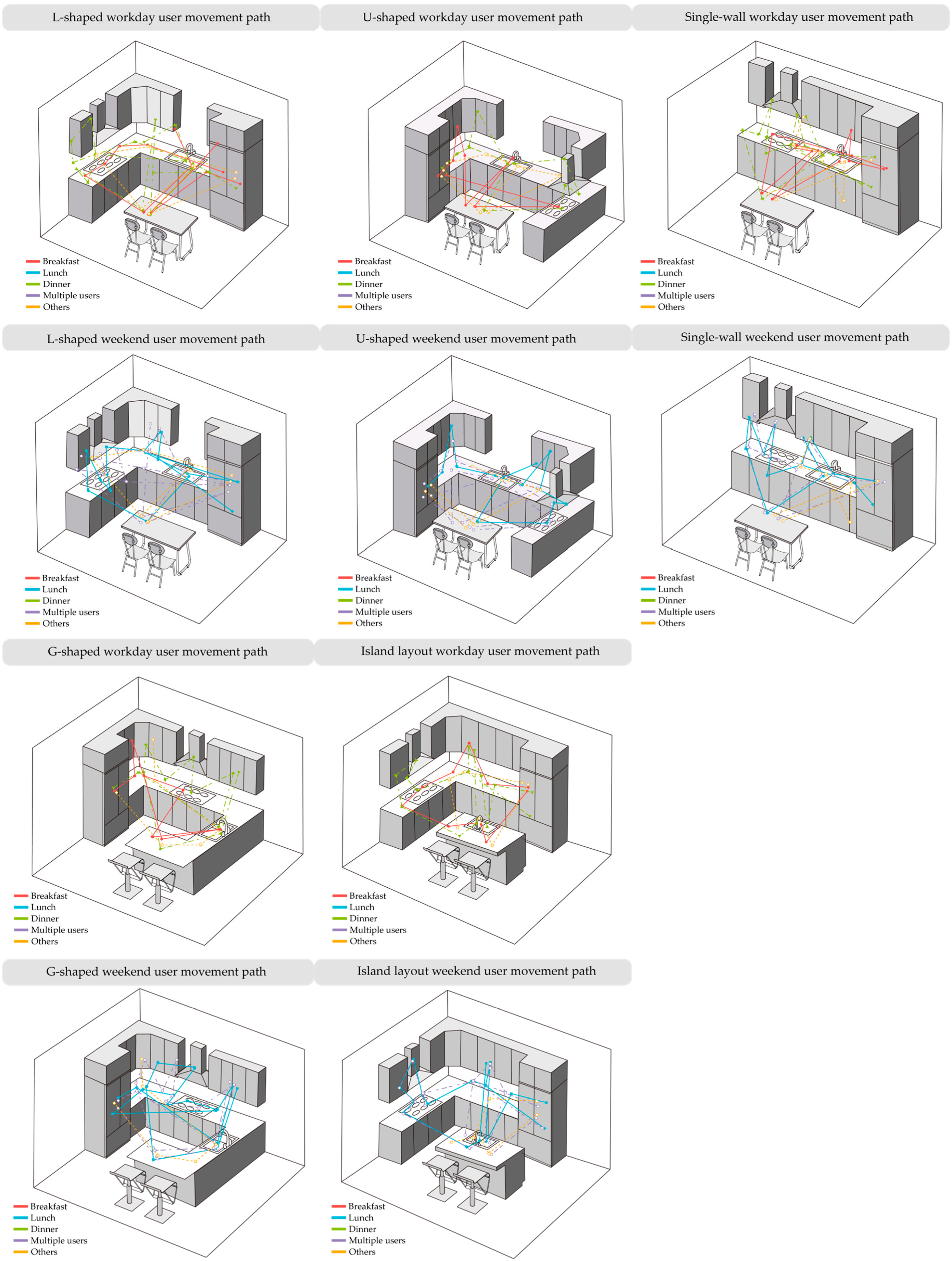
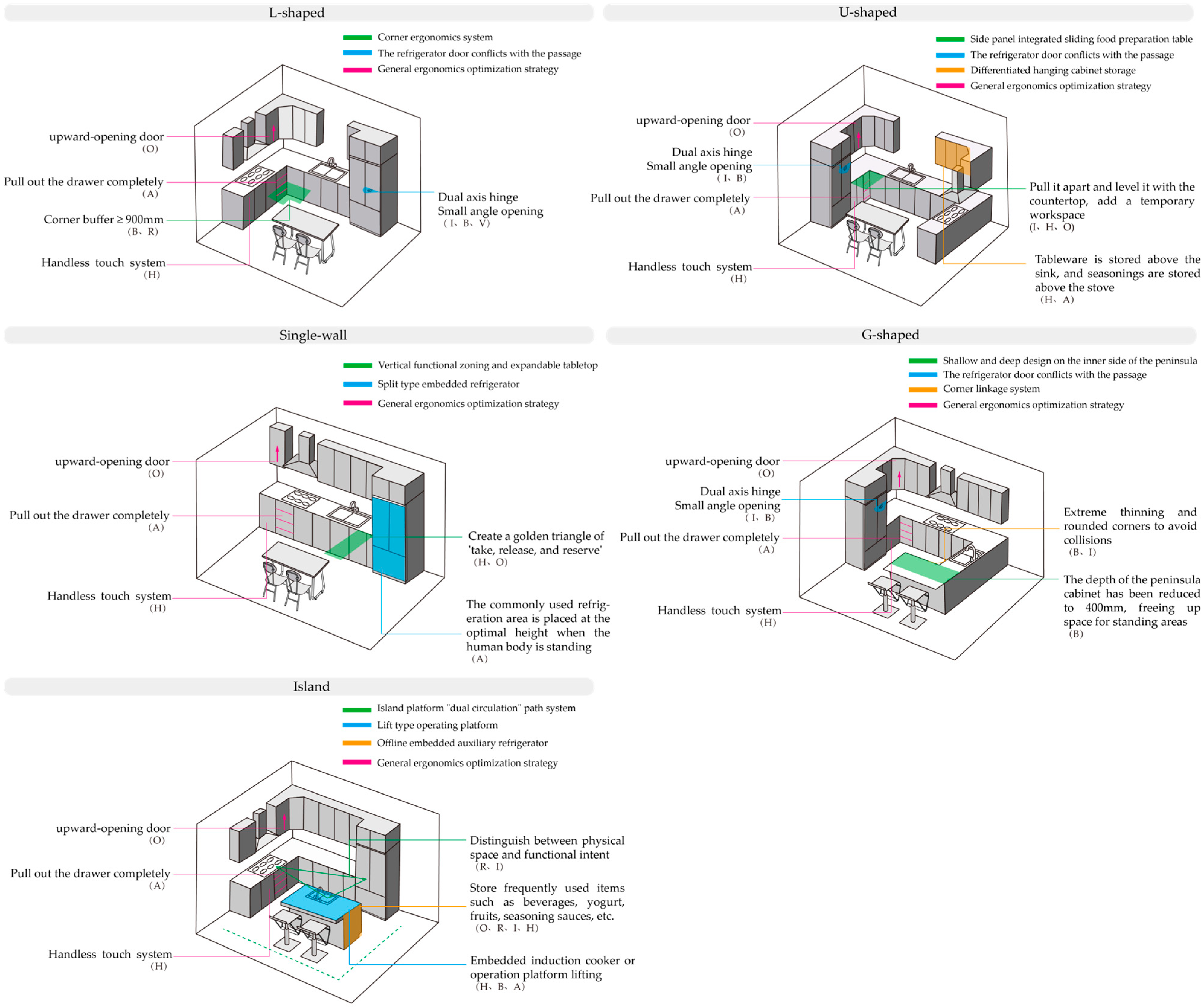
| Layout Type | Spatial Adaptability | Operational Adaptability | Path Clarity | Interference Control |
|---|---|---|---|---|
| L-shaped | 0.133 | 0.273 | 0.145 | 0.4489 |
| U-shaped | 0.1167 | 0.4359 | 0.1403 | 0.3071 |
| Single-wall | 0.149 | 0.2933 | 0.1333 | 0.4243 |
| G-shaped | 0.4488 | 0.2244 | 0.191 | 0.1357 |
| Island | 0.1411 | 0.3298 | 0.1411 | 0.388 |
| Sort | L-Shaped | U-Shaped | Single-Wall | G-Shaped | Island | |||||
|---|---|---|---|---|---|---|---|---|---|---|
| 1 | R | 0.2992 | A | 0.3295 | R | 0.2735 | B | 0.402 | O | 0.2301 |
| 2 | A | 0.1594 | O | 0.1947 | A | 0.2008 | I | 0.1644 | H | 0.2199 |
| 3 | O | 0.1496 | R | 0.1124 | O | 0.1509 | A | 0.1496 | R | 0.1579 |
| 4 | H | 0.1136 | H | 0.1064 | B | 0.1178 | R | 0.086 | A | 0.1099 |
| 5 | B | 0.087 | B | 0.0998 | H | 0.0925 | H | 0.0748 | B | 0.0941 |
| 6 | I | 0.0826 | I | 0.0961 | V | 0.0791 | O | 0.0497 | I | 0.0894 |
| 7 | V | 0.0624 | V | 0.0443 | I | 0.0542 | E | 0.0468 | V | 0.0516 |
| 8 | E | 0.046 | E | 0.0169 | E | 0.0312 | V | 0.0266 | E | 0.047 |
| Dimension | B | E | H | A | V | I | O | R |
|---|---|---|---|---|---|---|---|---|
| L-shaped | 6.273 | 7.394 | 6.424 | 6.924 | 6.970 | 5.561 | 7.682 | 7.409 |
| U-shaped | 5.273 | 7.439 | 5.439 | 6.030 | 7.470 | 3.439 | 6.424 | 6.030 |
| Single-wall | 8.409 | 7.636 | 5.697 | 9.091 | 6.652 | 5.348 | 4.788 | 6.288 |
| G-shaped | 6.485 | 7.318 | 8.576 | 7.015 | 8.379 | 4.439 | 7.500 | 7.485 |
| Island | 9.273 | 7.379 | 8.394 | 9.742 | 6.409 | 8.364 | 8.015 | 7.697 |
| Sort | B | E | H | A | V | I | O | R | |
|---|---|---|---|---|---|---|---|---|---|
| L-shaped | Information entropy value | 0.939 | 0.965 | 0.962 | 0.943 | 0.979 | 0.918 | 0.968 | 0.936 |
| Information utility value | 0.0619 | 0.035 | 0.038 | 0.057 | 0.021 | 0.082 | 0.032 | 0.064 | |
| weight coefficient | 0.1579 | 0.090 | 0.099 | 0.146 | 0.053 | 0.210 | 0.081 | 0.163 | |
| U-shaped | Information entropy value | 0.958 | 0.960 | 0.971 | 0.959 | 0.973 | 0.977 | 0.944 | 0.975 |
| Information utility value | 0.042 | 0.040 | 0.029 | 0.041 | 0.027 | 0.023 | 0.056 | 0.024 | |
| weight coefficient | 0.150 | 0.142 | 0.103 | 0.144 | 0.095 | 0.080 | 0.199 | 0.087 | |
| Single-wall | Information entropy value | 0.928 | 0.975 | 0.965 | 0.946 | 0.974 | 0.945 | 0.956 | 0.971 |
| Information utility value | 0.072 | 0.025 | 0.035 | 0.055 | 0.026 | 0.055 | 0.044 | 0.029 | |
| weight coefficient | 0.212 | 0.073 | 0.102 | 0.161 | 0.076 | 0.161 | 0.130 | 0.084 | |
| G-shaped | Information entropy value | 0.968 | 0.973 | 0.961 | 0.956 | 0.935 | 0.912 | 0.967 | 0.968 |
| Information utility value | 0.032 | 0.027 | 0.039 | 0.044 | 0.065 | 0.088 | 0.033 | 0.032 | |
| weight coefficient | 0.088 | 0.076 | 0.108 | 0.123 | 0.180 | 0.244 | 0.092 | 0.088 | |
| Island | Information entropy value | 0.897 | 0.943 | 0.937 | 0.716 | 0.939 | 0.968 | 0.946 | 0.962 |
| Information utility value | 0.103 | 0.057 | 0.063 | 0.285 | 0.060 | 0.032 | 0.054 | 0.038 | |
| weight coefficient | 0.148 | 0.082 | 0.091 | 0.4115 | 0.0875 | 0.046 | 0.079 | 0.055 | |
| Test | Value | |
|---|---|---|
| KMO (Kaiser-Meyer-Olkin) Measure of Sampling Adequacy | 0.882 | |
| Bartlett’s Test of Sphericity | Approximate Chi-Square | 1673.782 |
| Degrees of Freedom | 120 | |
| Significance | 0.000 | |
| Dimension | Describe | F | Significance |
|---|---|---|---|
| Body Clearance | Sufficient space when opening the refrigerator door | 78.992 | <0.001 |
| Sufficient space for body movement when retrieving items | 95.590 | <0.001 | |
| Embedded Compatibility | The refrigerator dimensions are well-matched with the cabinet/wall dimensions | 95.431 | <0.001 |
| The drawer and refrigerator door can be fully opened | 112.605 | <0.001 | |
| Handling Logic | The layout of storage compartments and control panel aligns with user habits | 85.886 | <0.001 |
| The control panel position is convenient for operation | 58.225 | <0.001 | |
| Accessibility | The position of the drawer and door handles is convenient | 149.910 | <0.001 |
| The internal height of the refrigerator is reasonable, allowing for smooth retrieval of items | 95.214 | <0.001 | |
| Visual Feedback | The refrigerator interface is clear and easy to recognize | 25.298 | <0.001 |
| The refrigeration/freezing zones are clearly defined, making items easy to locate | 26.351 | <0.001 | |
| Interaction Conflict | The usage path does not overlap with that of others | 113.874 | <0.001 |
| Simultaneous use by multiple people does not cause confusion | 132.962 | <0.001 | |
| Operating Time | The operation process is smooth, with a reasonable duration | 96.591 | <0.001 |
| The operation does not require repeated adjustments | 37.310 | <0.001 | |
| Requirement Indicator Layer | The refrigerator workflow is simple and direct, without detours | 170.445 | <0.001 |
| The retrieval path is clear and uncomplicated | 59.944 | <0.001 |
| Sort | L-Shaped | U-Shaped | Single-Wall | G-Shaped | Island | |||||
|---|---|---|---|---|---|---|---|---|---|---|
| 1 | R | 0.2448 | A | 0.2840 | R | 0.2146 | B | 0.2943 | A | 0.3128 |
| 2 | A | 0.1540 | O | 0.2359 | B | 0.1979 | I | 0.2451 | H | 0.1862 |
| 3 | I | 0.1337 | B | 0.1500 | O | 0.1685 | A | 0.1636 | O | 0.1853 |
| 4 | O | 0.1223 | H | 0.1255 | A | 0.1437 | V | 0.1242 | B | 0.1455 |
| 5 | B | 0.1151 | R | 0.1198 | I | 0.1294 | H | 0.1098 | R | 0.1278 |
| 6 | H | 0.1076 | I | 0.1059 | H | 0.1169 | R | 0.1044 | V | 0.0835 |
| 7 | E | 0.0638 | E | 0.0955 | V | 0.0931 | O | 0.0848 | I | 0.0812 |
| 8 | V | 0.0586 | V | 0.0835 | E | 0.0627 | E | 0.0738 | E | 0.0777 |
Disclaimer/Publisher’s Note: The statements, opinions and data contained in all publications are solely those of the individual author(s) and contributor(s) and not of MDPI and/or the editor(s). MDPI and/or the editor(s) disclaim responsibility for any injury to people or property resulting from any ideas, methods, instructions or products referred to in the content. |
© 2025 by the authors. Licensee MDPI, Basel, Switzerland. This article is an open access article distributed under the terms and conditions of the Creative Commons Attribution (CC BY) license (https://creativecommons.org/licenses/by/4.0/).
Share and Cite
Gao, Y.; Chen, Y.; Olarescu, A.; Liu, X. Optimizing Built-in Refrigerator Integration: BEHAVIOR Model for Evaluating Kitchen Workflow and Spatial Adaptability. Buildings 2025, 15, 3829. https://doi.org/10.3390/buildings15213829
Gao Y, Chen Y, Olarescu A, Liu X. Optimizing Built-in Refrigerator Integration: BEHAVIOR Model for Evaluating Kitchen Workflow and Spatial Adaptability. Buildings. 2025; 15(21):3829. https://doi.org/10.3390/buildings15213829
Chicago/Turabian StyleGao, Ying, Yushu Chen, Alin Olarescu, and Xinyou Liu. 2025. "Optimizing Built-in Refrigerator Integration: BEHAVIOR Model for Evaluating Kitchen Workflow and Spatial Adaptability" Buildings 15, no. 21: 3829. https://doi.org/10.3390/buildings15213829
APA StyleGao, Y., Chen, Y., Olarescu, A., & Liu, X. (2025). Optimizing Built-in Refrigerator Integration: BEHAVIOR Model for Evaluating Kitchen Workflow and Spatial Adaptability. Buildings, 15(21), 3829. https://doi.org/10.3390/buildings15213829






